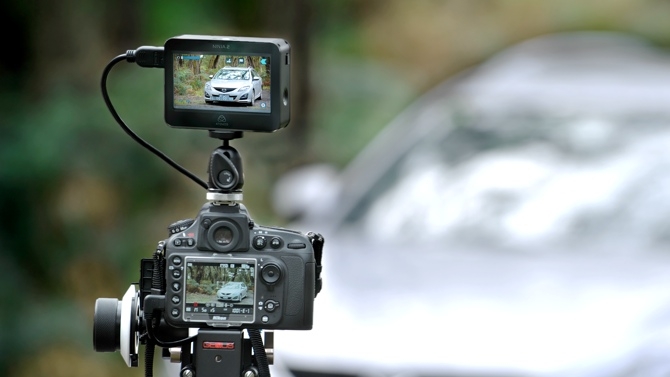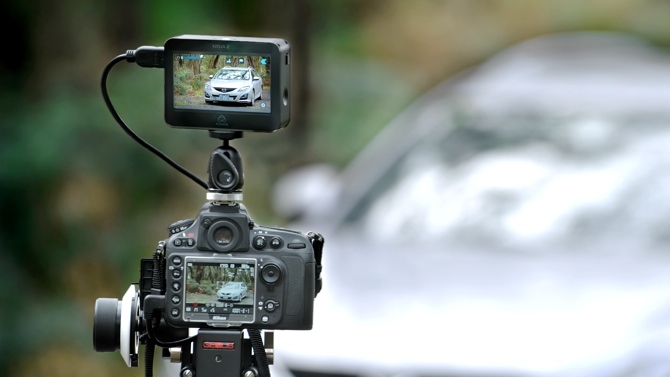
 Ninja 2 + Nikon D800
Ninja 2 + Nikon D800
Phil Rhodes looks at how you would use the Ninja 2 and Nikon D800 on a shoot. But first he compares HDMI and SDI.
The key technology to the combination of Atomos’s recorder and Nikon’s camera is HDMI, which can be a strange beast. Unlike SDI, it was not really – or in fact was not in any way – intended to be used as an interconnect between production equipment. HDMI, and the related DVI standard that preceded it, is designed pretty specifically to connect PCs and blu-ray players to TVs and monitors, and it has several features designed specifically for that purpose. Chief among those is the ability for the sending and receiving devices to communicate and decide on mutually compatible data formatting before transferring any images. This can introduce a delay on connecting the equipment that people used to the immediate feedback of a connected SDI cable may find off-putting.
HDMI is not designed for cameras or recorders
As a purely technical concern, practically all HDMI devices are 8-bit. There are theoretically protocols that provide for 10-bit data, but these are not widely supported and seem doomed to obscurity in a world where the first manufacturer to market a 10-bit HDMI device would find it almost always forced back to 8-bit modes when connected to extant gear. Canon, as we saw with the C300, is reluctant to give away high bit depth on its cameras in any case, but perhaps Nikon wears lighter political chains.
Physically, too, it’s clear that HDMI was never intended to be used on-set. Even DVI has large, chunky connectors somewhat akin to the type often called D-sub, that can be secured with jackscrews. HDMI retains the connector with the sprung friction of the contacts only, and even the best connectors are clearly domestic-grade. (You can get locking connectors now but I didn’t test any). That said, HDMI is a lot easier to implement electronically than SDI, and makes it possible for small, battery-powered devices (even cellphones) to drive large amounts of image data to displays. What’s possible with the D800 and Ninja 2 would not be possible without HDMI, and its problems can’t really be held at the door of either company, especially given the price to performance ratio it makes possible.
The Nikon D800 and Ninja 2 together as a production tool
Atomos thoughtfully supplied the review D800 with a plate providing a right-angle adaptor for the camera’s onboard mini-HDMI connector and I would consider this a must, making it far more difficult to damage the on-camera connector and providing adaption to a standard-sized HDMI connector into the bargain.
They also provided a hot-shoe mount, which is possibly less successful because it has a ball joint in the middle which raises the recorder a good couple of inches above the body of the camera. I found this awkward, though I’m sure lower-profile mounts are available, and the Ninja 2 recorder is adequately provided with top and bottom quarter-inch mounting points. I’m quite sensitive to the tendency of small, light, unobtrusive DSLRs to become big, heavy and obvious when festooned with too much gear. In some ways this is unavoidable, given the form factor of a DSLR, and the Ninja 2 recorder is far from heavy, but I'd recommend spending some time with the camera and recorder in a room with some mounting accessories and finding an approach that works for the production in question.
Ultimately I’m not sure if the D800 is the best camera to show off the recording capabilities of the Ninja. With moiré sometimes quite noticeable, it’s difficult to shift the impression that you’re just making a higher-fidelity recording of aliasing. That’s not really Atomos’ problem, though, and it isn’t even Nikon’s problem as the solution to it is well known – a lot more electronics, leading to more money and more battery power and lots of things you can’t really do on a DSLR. That’s what the C300 is for, and the blue-sky thinking that results from this is the idea that Nikon could probably make a competitor to the C300 without some of Canon's odder feature choices.
Even so I can see a thriving market for Atomos’ devices, with the imminent Panasonic GH3, which with any luck will have similar aliasing performance to the GH2, but without the 2’s occasionally shaky dynamic range and noise performance. These aren’t cameras you’d want to – or be able to – put a Codex recorder on, after all.In many cases the Atomos recorder will have a better display than the camera, and double as a monitor. I think all they need to do is fix the audio metering.
Tags: Production


Comments